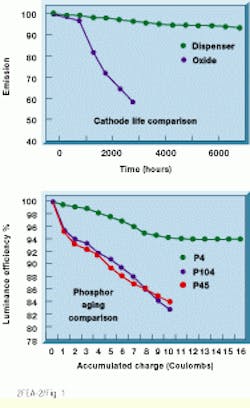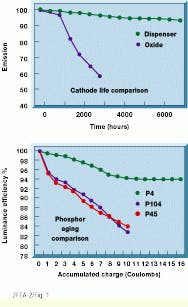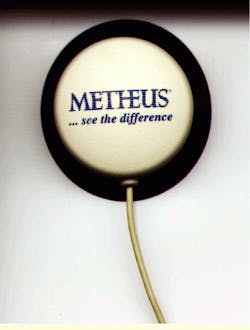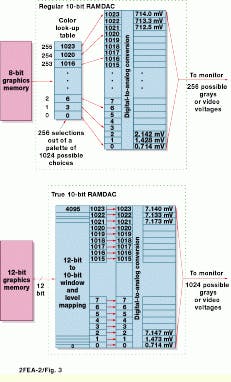HIGH-RESOLUTION MONITORS EXPLOIT TO SHARPEN MEDICAL IMAGES graphics cards
HIGH-RESOLUTION MONITORS EXPLOIT TO SHARPEN MEDICAL IMAGES graphics cards
By Andrew Wilson, Editor at Large
In high-end medical, military, and radar-display applications, imaging requirements mandate that 2048 ¥ 2048-pixel images and larger be displayed on very-high-resolution monitors. In such applications, gray-scale x-ray images can be as large as 2048 ¥ 2560 ¥ 10 bits. Because the complexity and cost of building display controllers and
monitors to meet these requirements have limited the market to just a few vendors, other vendors have focused on specific application areas such as medical imaging with products that are supported by application-specific software.
Although Siemens (Karlsruhe, Germany), Data Ray (Westminster, CO), and other suppliers offer monitors capable of displaying 2048 ¥ 2560-pixel images, resolution is only one of the key factors that must be considered when deciding on how to implement a high-end display subsystem. In medical applications, in particular, brightness, contrast, and refresh rate are important monitor specifications. To select a proper display controller, systems integrators must weigh such operational factors as bandwidth, look-up-table (LUT) design, software, and calibration support.
Monitor specifications
For its 21-in. SMM21190P 2048 ¥ 2560-pixel gray-scale monitor, Siemens specifies the brightness as 175 fL (600 cd/m2) with a 27% faceplate transmission. Similarly, the 21-in. DR110 2048 ¥ 2560-pixel monitor from Data Ray provides 120-fL brightness at 30% faceplate transmission. Unfortunately, these specifications do not furnish a complete representation of how such monitors will operate over time. Here, both cathode emission and phosphor aging are the two major contributing factors that affect monitor performance.
The performance of cathode emission depends on whether the monitor uses an oxide or a dispenser cathode. Similarly, the type of phosphor used in the monitor affects the luminance efficiency (see Fig. 1). Although the P4- and P104-type phosphors age more quickly and continue to age with use, P45-type phosphor tends to age more slowly and attains a stable level with accumulated charge. For a given current density, the luminance parameter is lower for the P45 phosphor.
In addition to phosphor aging, a small reduction in luminance occurs because of cathode degradation. However, the loss of luminance caused by both phosphor aging and cathode degradation can be recovered by recalibrating the monitor. Indeed, most currently available high-resolution monochrome monitors have been designed to allow this recalibration process to be performed several times. For this reason, both Dome Imaging Systems (Waltham, MA) and Metheus (Beaverton, OR) offer calibration tools to monitor, measure, and establish display consistency for digital medical-imaging workstations (see Fig. 2).
"The lack of calibration or consistent image display has a significant effect on the effectiveness of digital medical-image review products," says Karen Miller, Dome vice president of marketing."The drifts and shifts in emissive displays requiring the end user to tune the monitor impact productivity. And, the lack of clinical confidence in a product not capable of consistently rendering an image prevents its acceptance," she adds.
Calibration tools
Both the Dome Luminance Calibration System (LCS) and the Metheus P1500 photometer operate only with each company`s series of high-resolution graphics-display controllers. The Dome LCS, for example, operates with the company`s range of MD display-controller boards and acts as a photometer that can measure monitor luminance ranges from 0.5 to 300 fL and resolution to 10 bits (1024 gray levels). In operation, 10-bit data from the photometer is digitized and used to generate a 10-bit gamma-correction level, which is downloaded into the 10-bit LUTs incorporated into the graphics board RAMDAC.
The P1500 photometer from Metheus can be similarly used with the company`s P1540 2048 ¥ 2560 ¥ 12-bit PCI-based graphics controller. Like the Dome LCS, the P1500 photometer can measure luminance from 0 to 45 fL and recognize 10-bit image data.
But it is not only graphics-display-controller vendors that are adding calibration capability to their products. Monitor-vendor Clinton Electronics (Rockford, IL) has installed a photosensor, the True Image Sensor, directly on the CRT of all of its monitors. In operation, this sensor measures the total luminance and illuminance of the phos phor screen used to track display performance over time. Data are made available through an RS-232 port to the host PC or workstation. When used with a digitally controlled monitor, the sensor`s microprocessor can com mand the monitor`s controls to run calibration checks that include black-level and peak-white settings.
This added control capability also permits the measurement of ambient conditions and the compensation of the monitor`s settings to regain the dynamic range lost to ambient conditions. Better still, third-party display-controller cards with LUTs for gamma correction also can be integrated with the True Image Sensor for hands-free calibration cycles. Fully integrated systems also can be checked for performance via remote access, saving the time and service expenses associated with routine maintenance.
Although x-ray images are typically digitized to 12 bits, they are not displayed at this gray-scale resolution due to the limitations in current digital-to-analog-converter (DAC) technology. In many systems, x-ray images are first converted to 8 bits per pixel and stored in the graphics-controller on-board memory. By using an on-board RAMDAC with an integrated LUT, pixel values are mapped to 10-bit intensity values that are then fed to the on-board DAC. Even though the input intensity levels of the DAC can range from 0 to 1023 (10 bits), the 8-bit output limits the image displays to 256 levels (see Fig. 3). Moreover, only 256 gray levels can be seen. These so-called 10-bit DACs are used in both the Metheus P1540 and Dome MD5 graphics-display controllers.
"In the past few years, however, NEMA research groups have determined the number of just noticeable differences (JNDs), or levels of gray, that the human eye can discern," says Paul Chen, founder of Metheus. "One study shows that there are 438, 616, and 638 JNDs for peak monitor luminances of 160, 800, and 2400 cd/m2, respectively. And even though some manufacturers claim to use a 10-bit DAC on their controllers, in reality these boards are 8-bit frame buffers that can display a maximum of 256 gray levels (8 bits)," he comments.
Because of such studies, Metheus incorporated a true 10-bit DAC into its 2048 ¥ 2560-pixel PCI-based graphics controller, the P1540. Storing a 12-bit-deep image in memory, the board uses a 12-bit-in/10-bit-out LUT to map each pixel to a 10-bit intensity value. This operation provides a one-to-one mapping between the LUT output and the DAC input. "Consequently," says Chen, "the P1540 board can produce a 1024 gray-level output and deliver a higher number of JNDs than boards with 10-bit-in/8-bit-out DACs."
Getting flatter
Although the cathode-ray tube (CRT) has been the primary means of image display for more than 50 years, industry analysts insist that within the next ten years it will be replaced al most entirely by flat-panel-display (FPD) technology. In applications such as medical imaging, where 6-Mbyte image files are common, companies such as dpiX (Palo Alto, CA) have shown prototype active-matrix liquid-crystal displays (AMLCDs) that can display the 2048 ¥ 2560-pixel image formats required.
Although currently only capable of displaying 8 bits per pixel, the dpiX Gradient 500 flat-panel display provides a 19-in.-diagonal viewing area, a 0.147-mm uniform pixel pitch, and a luminance of approximately 200 fL. With such specifications rivaling high-resolution monitors, this flat-panel display can be loaded with high-resolution images at rates to 90 Mbyte/s.
To drive the Gradient 500 display, Metheus has developed an upgraded version of its P1540 graphics controller, the P1540F. Called the first PCI-based graphics controller to drive a 5-Mpixel display, the P1540F comes with 2048 ¥ 2560 ¥ 12-bit on-board image memory that can drive the flat panel at a 74-Hz refresh rate. In addition, multiple LUTs on the P1540F board allow image adjustments without affecting other images and allow images to be windowed and leveled individually or simultaneously in real time. Says Chen, "The double-buffered architecture eliminates any visual artifacts such as image tearing or flickering during the LUT process."
Although the cost of producing display controllers to meet the needs of medical OEMs has decreased, the medical-imaging market still remains specialized. Because of this, few OEMs have entered this market with display controllers specifically tailored to drive displays with 2048 ¥ 2560 ¥ 10-bit resolution.
Indeed, in medical-imaging applications other than x-ray analysis, such resolution may not be even required. In such cases, lower-cost image-processing boards may be a more cost-effective solution. And it is likely that future advances in IC integration will provide systems integrators with OEM solutions capable of performing both image processing and high-resolution graphics display.
FIGURE 1.Several factors affect the performance of high-resolution monitors, including the type of cathode used and the type of phosphor coating on the faceplate (top). Under heavy loading, a dispenser cathode will lose less of its emission value over time than an oxide cathode (bottom). Although the P4 and P104 phosphors age more quickly and continue to age with use, the P45 phosphor ages more slowly. But for a given current density, the luminance is lower for the P45 phosphor. (Courtesy of Data Ray)
FIGURE 2.Loss of luminance caused by both phosphor aging and cathode degradation can be recovered by recalibrating the monitor using screen-calibration tools from such companies as Metheus (top) and Dome Imaging Systems (bottom). These tools are used to monitor, measure, and establish display consistency for digital medical-imaging workstations.
FIGURE 3.Although x-ray images are typically digitized to 12 bits, their pixel values are usually mapped to 10-bit intensity values (top), which are then fed to a digital-to-analog converter (DAC) for display at 8 bits (256 levels). In its 2048 ¥ 2560-pixel PCI-based graphics controller, the P1540, Metheus has incorporated a 12-bit-in/10-bit-out LUT that provides 10-bit displays and 1024 gray levels (bottom). (Courtesy of Metheus)
HIGH-RESOLUTION GRAPHICS-BOARD MANUFACTURERS--A SAMPLING
Barco l Kennesaw, GA 30144 l (770) 218-3200 l Fax: (770) 218-3250 l Web: www.bds-america.com/
Dome Imaging Systems l Waltham, MA 02451 l (781) 895-1155 l Fax: (781) 895-1133 l Web: www.dome.com/
Folsom Research l Rancho Cordova, CA 95670 l (916) 859-2500 l Fax: (916) 859-2515 l Web: www.folsom.com/
Metheus l Beaverton, OR 97006 l (800)-Metheus l Fax: (503) 690-1525 l E-mail: [email protected] l Web: www.metheus.com/
Peritek l Oakland, CA 94619 l (510) 531-6500 l Fax: (510) 530-8563 l Web: www.peritek.com/
Primagraphics l Herts SG8 0SS, England l (44) 1763-852222 l Fax: (44) 1763-853324 l E-mail: [email protected] l Web: www.primag.co.uk/
Techsource l Altamonte Springs, FL 32701 l (407) 262-7100 l Fax: (407) 339-2554 l E-mail: [email protected] l Web: www.techsource.com/
HIGH-RESOLUTION MONITOR MANUFACTURERS--A SAMPLING
AFP Imaging l Elmsford, NY 10523 l (914) 592-6100 l Fax: (914) 592-6148 l Web: www.afpimaging.com/
Clinton Electronics l Rockford, IL 61111 l (815) 633-1444 l Fax: (815) 633-8712 l E-mail: [email protected] l Web: www.cec-displays.com/
Data Ray l Westminster, CO 80234 l (303) 451-1300 l Fax: (303) 451-1143 l E-mail: [email protected] l Web: www.data-ray.com/
dpiX l Palo Alto, CA 94304 l (650) 842-9600 l Fax: (650) 842-9808 l Web: www.dpix.com/
Dynamic Displays l Eau Claire, WI 54703 l (715) 835-9440 l Fax: (715) 835-2436 l Web: www.dynamicdis.qpg.com/
Image Systems l Minnetonka, MN 55343 l (612) 935-1171 l Fax: (612) 935-1386 l Web: www.imagesystemscorp.com/
Nortech Imaging Systems l Plymouth, MN 55447 l (612) 404-0226 l Fax: (612) 404-0227 l E-mail: [email protected] l Web: www.nortechsys.com/Imaging/
Siemens AG l 76181 Karlsruhe, Germany l (49) 721-595-6096 l Fax: (49) 721-595-2250
Siemens Microelectronics l Cupertino, CA 95014 l (408) 257-7910 l Fax: (408) 725-3439 l Web: www.ad.siemens.de/monitors/html_76/monochro.htm




